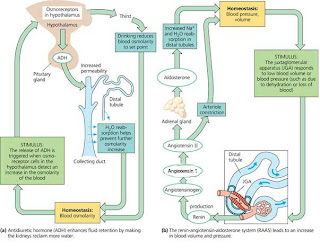Kidney functioning and regulating the volume and concentrating of body fluids
The kidneys are responsible for keeping the homeostatically constant, which is achieved by regulating the volume and concentration of body fluids by selectively filtering and reabsorbing materials from the blood.
Blood volume control and kidney function
The volume of fluid in various fluid compartments in the body depends on the balance of fluid intake and fluid output. Fluid intake in response to thirst is a source of fluid, and receptor cells found in the hypothalamus activate thirst when exposed to hypertonic conditions - such as when water loss has been excessive or salt intake high.
Anti-diuretic hormone (ADH) and kidney function
ADH or antidiuretic hormone or vasopressin is the hormone produced from the hypothalamus of the brain. It is secreted into the blood from the posterior lobe of pituitary. ADH is secreted when the osmoreceptors of hypothalamus detect an increased osmolarity or lesser water concentration in the blood. This causes thirst, and the released ADH makes the distal convoluted tubule and collecting duct of nephrons permeable to water. The primary effect of ADH is to limit the amount of water being lost in urine,. It is done by increasing the amount of reabsorption of water into the blood. The ADH targets the cells of the tubules and collecting ducts, which causes an increase of permeability of the cell surfaces, where the water then leaves the renal tubules in to the blood by means of osmosis.
With more fluid being reabsorbed, the blood volume increases
Aldosterone hormone - regulation of sodium and potassium and kidney function
ADH is not the only hormone that helps with the regulation of kidney function - aldosterone (from the adrenal cortex) as well as parathyroid hormone (from the parathyroid glands) affects the balance and regulation of electrolyte content of the blood and body fluids.
When aldosterone is present in the blood, the distal renal tubules increase their re-absorption of sodium and the secretion of potassium. With this action, more water is retained in the body
Aldosterone is secreted by the adrenal glands when the level of the potassium in the blood is increased, as well as the self-regulatory action of the kidneys by means of the renin-angiotensin system.
Renin-angiotensin system regulation of kidney function
When blood pressure increases so does the glomerular filtration increase, but when blood pressure falls, the filtration level drops and the glomerular filtration rate then needs another system to increase the filtration rate.
This is made possible by a specialized region of the nephron - the juxtaglomerular complex
In mammalian nephrons the distal convoluted tubule forms a secretory tissue near the Bowman’s capsule, in between the afferent and efferent arteriole, called Juxtaglomerular apparatus (JGA).It has directed contact with the afferent arteriole. If the blood pressure or blood volume in the afferent arteriole is decreased, the JGA secretes an enzyme called renin into the blood stream. Renin converts and inactive plasma protein angiotensinogen to active angiotensin II. This angiotensin II behaves like a hormone and increase blood pressure and blood volume by the following mechanisms.
1. It constricts arteries to reduce arterial volume, thereby increasing blood pressure.
2. It stimulates the proximal convoluted part of the nephrons to reabsorb more water, Na+ and Cl- ; which increase the blood volume.
3. It stimulates the adrenal gland to release aldosterone, enhances the re-absorption of water and Na+ by the distal convoluted part of nephrons. This activity further increase the blood volume.
Thus the Renin- Angiotensin- Aldosterone system (RAAS) regulate the renal function to raise blood volume and blood pressure to a higher level.
Increased blood volume and blood pressure stimulates the auricular wall of heart to produse another protein called Atrial Natriuretic Factor (ANF). It inhibits the release of renin from JGA. Thus the balanced interplay between RAAS and ANF helps to maintain the blood pressure and blood volume normal


No comments:
Post a Comment